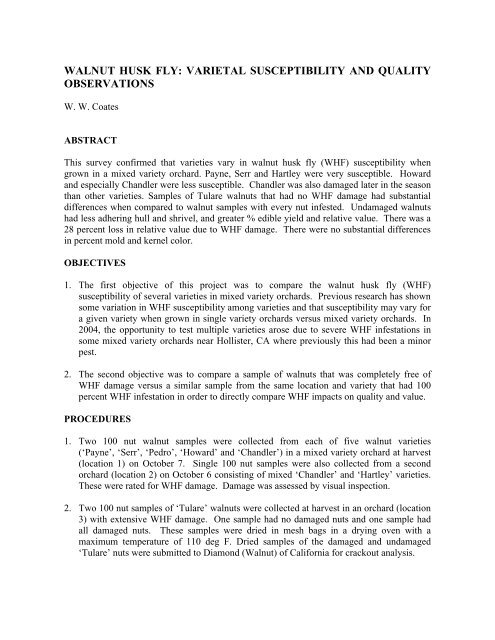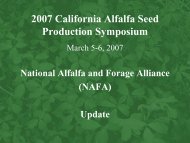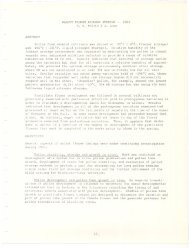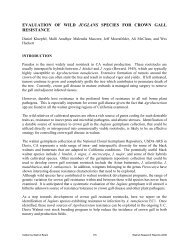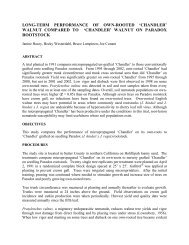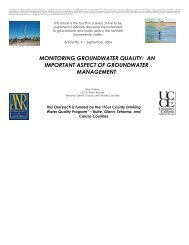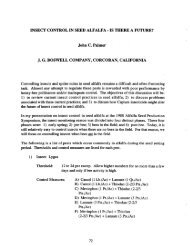Walnut Husk Fly Varietal Susceptability and Quality Observations
Walnut Husk Fly Varietal Susceptability and Quality Observations
Walnut Husk Fly Varietal Susceptability and Quality Observations
- No tags were found...
Create successful ePaper yourself
Turn your PDF publications into a flip-book with our unique Google optimized e-Paper software.
WALNUT HUSK FLY: VARIETAL SUSCEPTIBILITY AND QUALITYOBSERVATIONSW. W. CoatesABSTRACTThis survey confirmed that varieties vary in walnut husk fly (WHF) susceptibility whengrown in a mixed variety orchard. Payne, Serr <strong>and</strong> Hartley were very susceptible. Howard<strong>and</strong> especially Ch<strong>and</strong>ler were less susceptible. Ch<strong>and</strong>ler was also damaged later in the seasonthan other varieties. Samples of Tulare walnuts that had no WHF damage had substantialdifferences when compared to walnut samples with every nut infested. Undamaged walnutshad less adhering hull <strong>and</strong> shrivel, <strong>and</strong> greater % edible yield <strong>and</strong> relative value. There was a28 percent loss in relative value due to WHF damage. There were no substantial differencesin percent mold <strong>and</strong> kernel color.OBJECTIVES1. The first objective of this project was to compare the walnut husk fly (WHF)susceptibility of several varieties in mixed variety orchards. Previous research has shownsome variation in WHF susceptibility among varieties <strong>and</strong> that susceptibility may vary fora given variety when grown in single variety orchards versus mixed variety orchards. In2004, the opportunity to test multiple varieties arose due to severe WHF infestations insome mixed variety orchards near Hollister, CA where previously this had been a minorpest.2. The second objective was to compare a sample of walnuts that was completely free ofWHF damage versus a similar sample from the same location <strong>and</strong> variety that had 100percent WHF infestation in order to directly compare WHF impacts on quality <strong>and</strong> value.PROCEDURES1. Two 100 nut walnut samples were collected from each of five walnut varieties(‘Payne’, ‘Serr’, ‘Pedro’, ‘Howard’ <strong>and</strong> ‘Ch<strong>and</strong>ler’) in a mixed variety orchard at harvest(location 1) on October 7. Single 100 nut samples were also collected from a secondorchard (location 2) on October 6 consisting of mixed ‘Ch<strong>and</strong>ler’ <strong>and</strong> ‘Hartley’ varieties.These were rated for WHF damage. Damage was assessed by visual inspection.2. Two 100 nut samples of ‘Tulare’ walnuts were collected at harvest in an orchard (location3) with extensive WHF damage. One sample had no damaged nuts <strong>and</strong> one sample hadall damaged nuts. These samples were dried in mesh bags in a drying oven with amaximum temperature of 110 deg F. Dried samples of the damaged <strong>and</strong> undamaged‘Tulare’ nuts were submitted to Diamond (<strong>Walnut</strong>) of California for crackout analysis.
RESULTSThe results for the first objective are shown in Table 1. At location 1, ‘Payne’ averaged87.5%, ‘Serr’ 76.5%, ‘Pedro’ 57.0%, ‘Howard’ 27.0, <strong>and</strong> ‘Ch<strong>and</strong>ler’ 15.5% WHF damage.At location 2, ‘Hartley’ had 43% <strong>and</strong> ‘Ch<strong>and</strong>ler’ 5% WHF damage. In both orchards, WHFinfestation appeared to begin later in ‘Ch<strong>and</strong>ler’. The results for objective 2 are shown inTable 2. There were substantial differences in adhering hull (0% for undamaged, 98.5% fordamaged), % edible yield (52.24% for undamaged, 36.70% for damaged), <strong>and</strong> relative value(.9052 for undamaged, .6519 for damaged). This amounted to a 25 cent loss (28 percent) inrelative value due to WHF damage. Interestingly, there were no differences in % mold <strong>and</strong>minimal differences in color – all parameters assumed to be impacted by WHF infestation.DISCUSSIONThe University of California publication (publication #3270) “Integrated Pest Managementfor <strong>Walnut</strong>s, 3 rd edition” (IPMW) 3 states that ‘Franquette’, ‘Hartley’ <strong>and</strong> ‘Tulare’ are verysusceptible to WHF. This project confirms that documented susceptibility for ‘Hartley’.However, IPMW also states that ‘Payne’ is fairly susceptible <strong>and</strong> ‘Serr’ is fairly tolerant. Thisdoes not agree with past field observations in San Benito County where ‘Payne’ <strong>and</strong> ‘Serr’ areconsidered very susceptible with high WHF population pressure. This year’s results agreewith these past local observations – ‘Payne’ <strong>and</strong> ‘Serr’ were both very susceptible. Inagreement with IPMW, ‘Howard’ <strong>and</strong> especially ‘Ch<strong>and</strong>ler’ appear to be somewhat tolerant.Past observations of ‘Ch<strong>and</strong>ler’ also confirm findings this year that this variety is infestedlater in the season than other varieties. An objective for 2005 will be to document the timingof damage in several varieties including ‘Ch<strong>and</strong>ler’ throughout the WHF damage season(June-September).The results of the direct comparison of infested <strong>and</strong> uninfested ‘Tulare’ walnuts confirm thatthere were substantial WHF impacts on % adhering hull, % edible yield, % shrivel <strong>and</strong>relative value. There were no differences in % mold <strong>and</strong> minimal differences in kernel colorbetween the damaged <strong>and</strong> undamaged nuts. This agrees with other recent WHF research inthis orchard with this variety 1 . This disagrees with older observations including some by thisauthor 2,3 . This may be a varietal difference with ‘Tulare’ versus some older varieties thatwere previously evaluated.<strong>Walnut</strong> husk fly susceptibility has been a very important factor for organic walnut productionin the Central Coast. ‘Ch<strong>and</strong>ler’ has been recommended as the variety of choice because ofreduced incidence of walnut blight, codling moth <strong>and</strong> WHF. With the introduction oforganically acceptable insecticides for WHF management (GF-120, Entrust + NuLure bait<strong>and</strong> Surround), the importance of this factor has been reduced but a reduction in the number<strong>and</strong> total cost of sprays is still a factor in favor of ‘Ch<strong>and</strong>ler’.
TABLE 1: WALNUT HUSK FLY – VARIETAL SUSCEPTIBILITY - 2004Location Variety %WHF MEAN % WHF1 Payne 89 87.51 Payne 861 Serr 73 76.51 Serr 801 Pedro 52 57.01 Pedro 621 Howard 21 27.01 Howard 331 Ch<strong>and</strong>ler 14 15.51 Ch<strong>and</strong>ler 172 Hartley 43 43.02 Ch<strong>and</strong>ler 5 5.0TABLE 2: COMPARISON OF NUT CHARACTERISTICS FROM ‘TULARE’WALNUT SAMPLES WITH AND WITHOUT DAMAGE BY WHF – 2004%ADHERING %EDIBLE %MOLD %SHRIVEL RVHULLYIELD__________________________________________________________________________DAMAGE 98.5 36.70 0.00 4.50 0.6519NO DAMAGE 1.4 52.24 0.00 0.00 0.9052FOOTNOTES1. <strong>Husk</strong> <strong>Fly</strong> (Rhagoletis completa) Control in English <strong>Walnut</strong>s”, <strong>Walnut</strong> ResearchReports – Coates, W.W. <strong>and</strong> R.A. Van Steenwyk. “Evaluation of Kaolin (Surround)for <strong>Walnut</strong> 2002 pp 375-380. <strong>Walnut</strong> Marketing Board, Sacramento, CA.2. Coates, William W. “Relating <strong>Walnut</strong> <strong>Husk</strong> <strong>Fly</strong> Damage to Nut Size”, <strong>Walnut</strong>Research Reports – 1994, pp 190-193. <strong>Walnut</strong> Marketing Board, Sacramento, CA.3. Str<strong>and</strong>, Larry L. (editor). Integrated Pest Management for <strong>Walnut</strong>s, 3 rd Edition,University of California Agricultural <strong>and</strong> Natural Resources Publication 3270, p 52.


